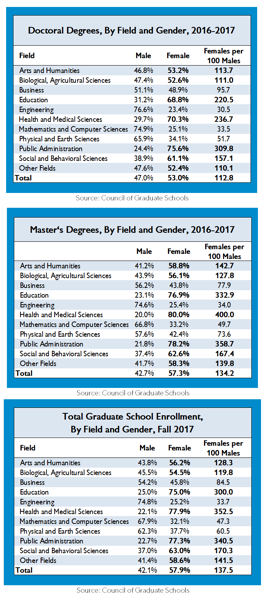
The Council of Graduate Schools (CGS) released its annual report today on US graduate school enrollment and degrees for 2017
MJP lists the more interesting findings in this year’s report:
- For the ninth year in a row, women earned a majority of doctoral degrees awarded at US universities in 2017. Of the 79,738 doctoral degrees awarded in 2017 (Table B.25), women earned 41,717 of those degrees and 53% of the total, compared to 37,062 degrees awarded to men who earned 47% of the total (see top chart above). Women have now earned a majority of doctoral degrees in each academic year since 2009, and the 53% female share last year is a new record high. Previously, women started earning a majority of associate’s degrees for the first time in 1978, a majority of master’s degrees in 1981, and a majority of bachelor’s degrees in 1982 according to the Department of Education. Therefore, 2009 marked the year when men officially became the “second sex” in higher education by earning a minority of college degrees at all college levels from associate’s degrees to doctoral degrees.
- By field of study, women earning doctoral degrees in 2017 outnumbered men in 7 of the 11 graduate fields tracked by the CGS (see top chart above): Arts and Humanities (53.2% female), Biology (52.6% in one of the main STEM fields, despite the frequent narrative that females are so under-represented in STEM), Education (69.8%), Health and Medical Sciences (70.3%, isn’t that another STEM field?), Public Administration (75.6%), Social and Behavioral Studies (61,1%) and Other fields (52.4%). Men still earned a majority of 2017 doctoral degrees in the fields of Business (51.1% male), Engineering (76.6%), Math and Computer Science (74.9%), and Physical and Earth Sciences (65.9%).
- The middle chart above shows the gender breakdown for master’s degrees awarded in 2017 (from Table B.24) and the gender disparity in favor of females is significant – women earned 57.3% of all master’s degrees in 2017, which would also mean that women earned more than 134.2 master’s degrees last year for every 100 degrees earned by men. Like for doctoral degrees, women outnumbered men in the same 7 out of the 11 fields of graduate study and in some of those fields the gender disparity was huge. For example, women earned 400 master’s degrees in health and medical sciences for every 100 men, more than 358 master’s degrees in public administration for every 100 men and 339 master’s degrees in education for every 100 men.
- The bottom chart above displays total graduate enrollment in fall 2017 by gender and field for all graduate school programs in the US (certificate, master’s and doctoral degrees from Table B.13), showing that there is a significant gender gap in favor of women for students attending US graduate schools. Women represent 57.9% of all graduate students in the US, meaning that there are now more than 137 women enrolled in graduate school for every 100 men. In certain fields like Education (75% female), Health and Medical Sciences (78% female) and Public Administration (77.3%), women outnumber men by a factor of three or more. By field of study, women enrolled in graduate school outnumber men in the same 7 out of the 11 graduate fields of study noted above, with females being a minority share of graduate students in only Business (45.8% female), Engineering (25.2% female), Math and Computer Science (32.1% female), and Physical and Earth Sciences (37.7% female).